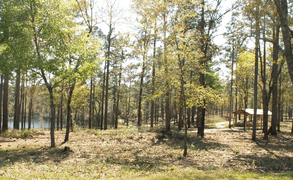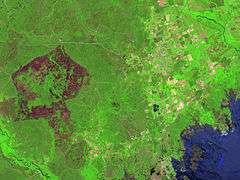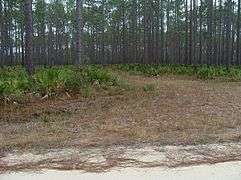Apalachicola National Forest
| Apalachicola National Forest | |
|---|---|
|
IUCN category VI (protected area with sustainable use of natural resources) | |
|
| |
 | |
| Location | Florida, USA |
| Nearest city | Tallahassee, FL |
| Coordinates | 30°14′10″N 84°39′56″W / 30.23611°N 84.66556°WCoordinates: 30°14′10″N 84°39′56″W / 30.23611°N 84.66556°W |
| Area | 632,890 acres (256,120 ha)[1] |
| Created | May 13, 1936 |
| Governing body | U.S. Forest Service |
| Website | Apalachicola National Forest |
The Apalachicola National Forest is the largest U.S. National Forest in the state of Florida. It encompasses 632,890 acres (988.89 sq mi; 2,561.2 km2)[1] and is the only national forest located in the Florida Panhandle. The National Forest provides water and land-based outdoors activities such as off-road biking, hiking, swimming, boating, hunting, fishing, horse-back riding, and off-road ATV usage.[2]
Apalachicola National Forest contains two Wilderness Areas: Bradwell Bay Wilderness and Mud Swamp/New River Wilderness. There are also several special purpose areas: Camel Lake Recreation Area, Fort Gadsden Historical Site, Leon Sinks Geological Area, Silver Lake Recreation Area, Trout Pond Recreation Area, and Wright Lake Recreation Area. In descending order of forest land area it is located in parts of Liberty, Wakulla, Leon, and Franklin counties. The forest is headquartered in Tallahassee, as are all three National Forests in Florida, but there are local Forest ranger district offices located in Bristol and Crawfordville.
Hunting and fishing
Hunting and fishing are monitored and governed by the Florida Fish and Wildlife Conservation Commission (FWC). The national forest itself is a wildlife management area. The FWC divides the management area into sections that allow dog hunting, still hunting, and private property. Modern gun season for large game starts Thanksgiving weekend and ends in January.[3]
Environment
The Apalachicola National Forest is in the southeastern conifer forests ecoregion. Areas of the national forest with dry, sandy soils support Florida longleaf pine sandhills and east Gulf coastal plain near-coast pine flatwoods. Sandhills are woodlands dominated by longleaf pine (Pinus palustris). Pine flatwoods are forests and woodlands on broad, sandy flatlands. Both of these pine communities are sustained by frequent fires.[4]
Near the floodplains of spring-fed rivers grow southern coastal plain hydric hammocks, dense forests of evergreen and deciduous hardwood trees. Blackwater rivers support southern coastal plain blackwater river floodplain forests of baldcypress (Taxodium distichum) along their banks. Major rivers support diverse east Gulf coastal plain large river floodplain forests.[4]
The National Forest is also home to several wetland plant communities. Southern coastal plain nonriverine basin swamps are large, seasonally flooded depressions of baldcypress (Taxodium distichum) and swamp tupelo (Nyssa biflora). East Gulf coastal plain savannas and wet prairies are low, flat plains covered in grasses and sedges, which are seasonally flooded and maintained by frequent fires. Southern coastal plain nonriverine cypress domes are small wetlands of pond cypress (Taxodium ascendens) notable for their dome-shaped appearance.[4]
The Forest contains thousands of acres of old growth Pond Cypress swamps (cypress domes). In addition, Bradwell Bay Wilderness contains about 100 acres (40 ha) of old-growth Slash Pine - Swamp Tupelo swamps.[5]
Gallery
-
Hunters listening for the direction of dogs following the scent of a white tail deer
-
An artificial pond off of FH-111
-
Silver Lake Recreation Area, a part of the Apalachicola National Forest, about 8 miles (13 km) from Tallahassee, Florida, in 2007
-

Trout Pond Recreation Area, a part of the Apalachicola National Forest, about 6 miles (9.7 km) south of Tallahassee
-

This image shows a large area burned by a forest fire, which appears as dark pink ring-shaped patch at the left side of the image
-

An unimproved road in the Wildlife Management Area off of Hwy. 67
See also
References
- 1 2 "Land Areas of the National Forest System" (PDF). U.S. Forest Service.
- ↑ http://www.stateparks.com/apalachicola.html
- ↑ Florida Fish and Wildlife Conservation Commission
- 1 2 3 "Land Cover Viewer - Map". National Gap Analysis Program. United States Geological Survey. Retrieved 10 February 2013.
- ↑ Mary Byrd Davis (23 January 2008). "Old Growth in the East: A Survey. Florida" (PDF). Retrieved 2008-12-31.
External links
| Wikimedia Commons has media related to Apalachicola National Forest. |
 Apalachicola National Forest travel guide from Wikivoyage
Apalachicola National Forest travel guide from Wikivoyage- Apalachicola National Forest official site at United States Forest Service
- The Florida Trail in the Apalachicola National Forest
- Field Guide to Flora in Apalachicola National Forest